The destruction of Downtown Louisville by twelve lanes of steel and concrete—about 280 feet wide when massive shoulders are added in—began yesterday with the ceremonial wrecking of a portion of the historic Vermont American Building on the corner of Main and Jackson streets. Governor Beshear, Mayor Fischer, Congressman Yarmuth, Metro Council-member Tandy, and a cadre of other officials gathered to mark the occasion of what’s being billed as the start of the Downtown portion of the Ohio River Bridges Project.

While the VA demolition is the first official building lost to the highway, it’s not the first loss due to the project. The first building to fall that can be linked to the Bridges Project was located a couple blocks to the south, a two-and-a-half-story 19th-century brick commercial building, on the corner of Jefferson and Jackson streets. The structure suffered damage to its roof during Hurricane Ike several years ago but was torn down instead of repaired. Seeing as it sits in the right-of-way of the new highway, however, it would have fallen anyway.

The latest casualties of driving a highway through Downtown Louisville are the Baer Fabrics building on Market Street and the eastern half of the Vermont American building on Main Street. Also in jeopardy or facing uncertain futures but not immediately threatened are the western half of the VA building, two small buildings on Jackson Street that are connected to the Baer building, and what remains of the Grocer’s Ice & Cold Storage building on Main Street (the building lost its top two floors in a fire decades ago, last housed Creation Gardens before it moved, and will see some demolition on it’s northwestern side).
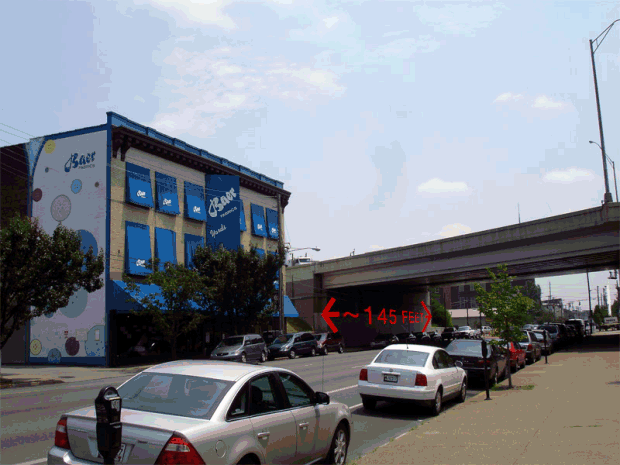
The four structures that may be reused are now owned by the state but don’t cover land immediately needed to build the highway. The state will consider selling them to interested private investors as surplus land. Kentucky Transportation Cabinet ORBP Project Manager Gary Valentine said one private group has stepped forward with interest in the western half of the VA building, which was advertised for sale at the end of May/beginning of June. A decision must be made 90 days after the property is first advertised. Valentine said the state is now in the processes of advertising the two auxiliary Baer properties and the Grocer’s Storage building will follow.
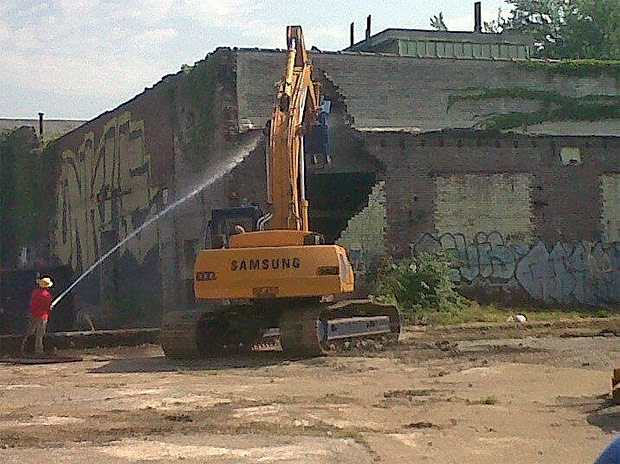
In 2002, a group of investors including Henry Potter, Phil Scherer, and Dale Boden (developers of the Fleur-de-Lis condos down the street) had planned to invest $6 to $8 million in the Vermont American building to convert it into offices and retail space. The site is contaminated from its previous use as a tool-making factory, but an agreement had been reached for the tool company’s parent to pay for clean-up costs, estimated at around $100,000. (Bosch subsequently bought VA, moved its corporate offices to suburban Chicago, and will pay to clean-up the site during the current demolition process.) Potter, principal at architectural firm Potter & Associates, told Business First at the time that the property “is really in very good shape.” As the buildings languished, however, some decay has become apparent in the structure’s brickwork (see photos below).
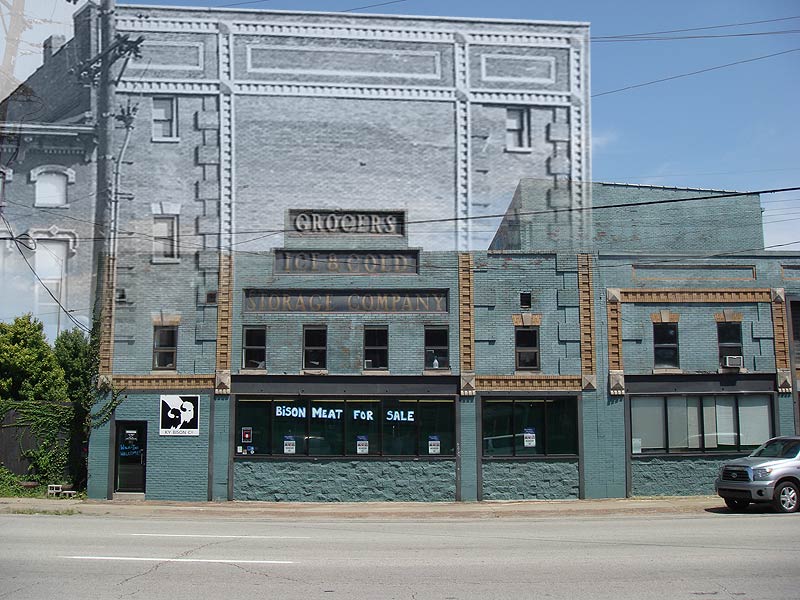
While it’s heartening to hear a group is interested in working with what will remain of the Vermont American building, the physical gap in the urban fabric brought about by a 280-foot-wide, 12-lane Interstate highway slicing off Louisville’s most vibrant urban neighborhood—Nulu—from Downtown is sure to be felt as the city continues to push for a livable, walkable, urban core.


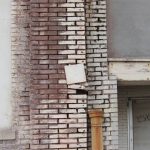

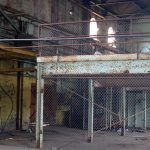

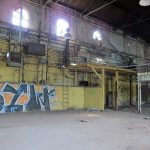




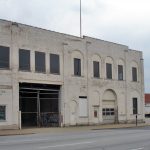
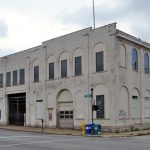
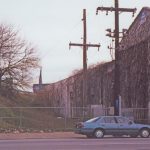





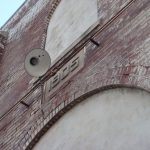

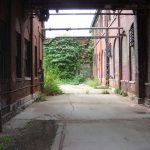

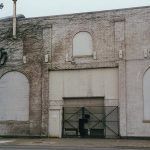






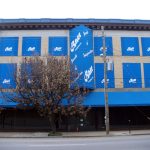

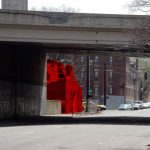

And so, the horrifying destruction of our downtown continues— to appease those who believe the only way to move people and goods is to pave over the world. Job creation should not be done by historical and environmental destruction.
How do the people of NULU feel about this, they have done quite a bit in that area, that 280′ will include some of their nicer space, and what about Joe Ley Antiques? Or is my geography off?
I know for a fact that the top brass wants to save as much of the VA building as possible. They’re planning to help pay for the environmental remediation so that the building can be purchased and renovated. I also know that they are planning to use parking lots (mainly those serving Slugger Field and the extreme park) to store equipment and building materials.
@William Huston – As a Nulu resident I can’t speak for “everyone”, but I do end up walking downtown a lot and I already see the existing overpasses already as a silent barrier that can be irritating to cross and essentially defines development borders already. Making those overpasses larger would indeed, at the very least psychologically, increase the disconnect between between Nulu/Butchertown and “Downtown proper” even if physically they will be the same distance as they ever were.
This could be at least mitigated somewhat if TARC could run more Market Street trolleys, particularly evenings and weekends… but no one seems to consider TARC routes outside of those two Fridays a month…
This makes me so very very sad. How can we celebrate a highway as progress in this day and age? Do we want an Embarcadero or a Big Dig situation? I can’t believe the community has no say in this.
The expansion of the downtown bridge is a step backward. It shows that our political leadership lacks an understanding of what a downtown should be. Rather than “shrinking” the east end bridge to four lanes it should have been expanded to eight lanes. All through truck traffic should be diverted to the east and west bridges. Only automobile and local truck traffic should be allowed to go through the center of the city.
The new expanded downtown bridge will be a complete disaster.
I live downtown, and, will not be sad to see these eyesores torn down (they are warehouses, for crying out loud!). The HPS seems to label everything as “historical” and pressure businesses to build elsewhere – thus contributing to the, even uglier, sprawl throughout the rest of the county (and the requisite traffic jams that creates). The highway desperately needs to be expanded – not just for commerce, but for safety reasons (how many people have died on I65 already?). Let’s stop tearing up the countryside and rebuild the city!
@Dave – My concern is that by expanding the interstate through downtown, we are actually encouraging additional suburban sprawl further away from the city center and making development less desirable adjacent to the expanded interstate corridor through downtown. In other words, an expanded interstate will have the consequence of tearing up the countryside and discouraging redevelopment within the city.
It is about time the infrastructure in this town is expanded. Cincinnati, St. Louis, and Indianapolis have long passed up Louisville. Better highways brings more businesses and therefore more jobs to town. Get rid of the useless buildings, they have zero potential and are horrible from an energy efficiency standpoint. Next step, forget the tunnel in the east end, knock down a few more useless old houses and complete the outer beltway. Let’s grow Louisville!
Don’t plan on going downtown for the next 10 years!
Hu, S., S. Fruin, et al. (2009). “A wide area of air pollutant impact downwind of a freeway during presunrise
hours.” Atmospheric Environment, vol. 43(16): 2541-2549.
Synthesizing monitoring results near highways from 41 monitoring studies published in the peer reviewed
literature from 1978 to 2008. Generally, new scientific studies show that a cloud of ultra-fine particulate
increases from background level concentrations at points distant, to elevated concentrations at the
roadway edge. While regional design standards PM 2.5 readings based on gravimetric analysis, the
federal standard method, show little to no increase from background levels as one approaches the edge of
the road, both Carbon Monoxide and ultrafine particulate show dramatic increases.
“In this study, real-time air pollutant concentrations were measured along a 3600 m transect normal to
an elevated freeway 1–2 h before sunrise using an electric vehicle mobile platform equipped with fastresponse
instruments. In winter pre-sunrise hours, the peak ultrafine particle (UFP) concentration
(∼95 000 cm−3) occurred immediately downwind of the freeway. However, downwind UFP
concentrations as high as ∼40 000 cm−3 extended at least 1200 m from the freeway, and did not reach
background levels (∼15 000 cm−3) until a distance of about 2600 m. UFP concentrations were also
elevated over background levels up to 600 m upwind of the freeway. Other pollutants, such as NO and
particle-bound polycyclic aromatic hydrocarbons, exhibited similar long-distance downwind
concentration gradients.”
If they take down the VA building, the old Creation Gardens building, and use the skatepark for parking construction equipment, what will the lowlife vandals have left to ruin?
Joe Ley will be fine…and I’m loving the new JL mural facing I-65!!
I hope I live long enough to see these city slicing interstates removed. To be expanding these now is an error and a huge expense. When they built the ring highways, everyone was going to use those and go around the core of the city – what happened to that concept?
@Charlie Williams – In the more progressive cities with competent leadership, worldwide, the thru truck traffic is directed around the cities.
So why aren’t we speaking up? Between this and the new preservation ordinance, I’m afraid we’ll be seeing way more parking lots and demo downtown. It’s truly heartbreaking and I’m baffled that our leaders are touting this as progress. Really? How can they honestly say that?! And why are we allowing it?
@Charlie Williams – River fields got in the way of that idea! Mayor Abramson placated them by adding the downtown bridge. Look at the designs, you can’t even get on the new 265 northbound from U.S. 42 nor can you exit onto U.S. 42 going southbound! Tell me what sense that makes?
Mark, it makes as much sense as there being absolutely no ramps on 71 from 264 all the way to 265. The punks with money make sure the traffic remains elsewhere. If the beltway must be completed, they’ll do all they can to stall, snowball costs, and keep the sprawl (sure to follow the beltway) well away from their homes.
Sad. Another American city ripping itself apart so people can cut a few minutes off of their commute. How much is this costing? Of course, the federal government is going to pick up 90% of the cost, but the state of Kentucky will be responsible for all of the maintenance. This is patronage for well connected engineering and construction firms.